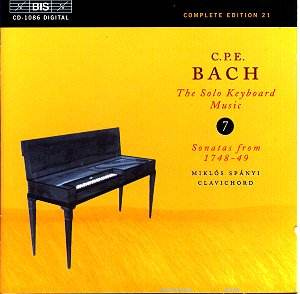Carl Philipp Emanuel Bach was the most illustrious
of Johann Sebastian Bach’s sons. His composing career was long and he
was quite prolific, writing dozens of sonatas, concertos and other works.
(According to Miklós Spányi, there are 52 keyboard concertos
and 12 sonatinas, in addition to the many solo keyboard works.) This
recording contains five sonatas for clavichord.
Miklós Spányi continues his monumental
inventory of Carl Philipp Emmanuel Bach’s solo keyboard music with another
selection of five sonatas for clavichord, each in the standard three-movement
sonata form. CPE Bach was a master of these works, infusing them with
a great deal of melodic invention and a wide variety of tone and form.
While the clavichord is by its very nature an intimate and discreet
instrument, one can hear Bach’s genius here in the subtle chromatic
melodies and joyous phrases.
Most of these works begin with a long first movement;
in most cases this first movement is the longest movement of the work
(all but the D minor sonata, where the first movement is about 30 seconds
shorter than the third movement). Bach develops a wide palette of themes
in these first movements, and Spányi plays them with a great
deal of feeling. His clavichord on this recording has a beautiful sound
(don’t forget, you should never play a clavichord recording too loud),
and his ornamentation is always tasteful.
The middle movements of these works show the unique
nature of the clavichord, and its muted resonance. Bach was probable
the most prolific composer for this instrument, and perfected solo clavichord
sonatas. The final movements, allegros, prestos and an allegro di molto,
are more rhythmic and dance-like music, again displaying Bach’s wide
range of compositional talent.
Yet another excellent volume of solo keyboard works
adds to this monumental series by Miklós Spányi. CPE Bach
is clearly the most important composer for this instrument, and the
variety of music he wrote is an endless source of discovery.
Kirk McElhearn


